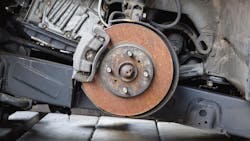Quick tips to avoid being out of service during Brake Safety Week
Brake Safety Week is nearly upon us. This year it is Aug. 20-26. According to the Commercial Vehicle Safety Alliance (CVSA), “During Brake Safety Week, commercial motor vehicle inspectors highlight the importance of brake systems by conducting inspections of their components and removing commercial motor vehicles found to have brake-related out-of-service violations from our roadways until those violations are corrected.”
In 2022, “Commercial motor vehicle inspectors in Canada, Mexico and the U.S. conducted 38,117 inspections of commercial motor vehicles for Brake Safety Week. Of the total number of the commercial motor vehicles inspected, 13.3% were placed out of service for brake-related critical vehicle inspection item violations,” CVSA said on its website.
See also: CVSA's Brake Safety Day removed over 750 CMVs
I wanted to share some quick inspection tips with you that can help reduce brake violations and keep your trucks on the road after an inspection. I turned to Joe Puff, NationaLease’s VP of truck technology and maintenance, for some advice. His first suggestion was that you refer to the code regulations listed in FMCSA/DOT Regulations Sections 393 and 396.
Here are the rest of Puff’s suggestions:
- Check brake components for missing, loose, or broken components, including lining, pads, drums, rotors, chambers, slacks, mounting, etc.
- Inspect brake lines and hoses for leaks, cracking, chafing, kinks, bulging, rotting, and sub-par repairs. Pay particular attention to the trailer air lines to see if they are rubbing on other components or the catwalk. Even small air line kinks and chafing can lead to a violation.
- Listen for audible air leaks particularly around chambers, axles, trailer lines, and in the cab. Check for air leaks with and without the brakes applied.
- Drain water from the air tanks. If you have hydraulic brakes, inspect all lines, cylinders, and parts for signs of brake fluid leaking. Check the brake fluid level.
- Test the low air pressure warning device and ABS indicator light to ensure they are functioning properly.
- Check brake adjustment. The requirements and maximum pushrod stroke must not exceed the values listed in the Code of Federal Regulations § 393.47(e). Requirements vary by brake type, size, and “standard” or “long” stroke chambers.
- Inspect brake drums and rotors. Some things to look for include, but are not limited to, gouges or cracks in the drum or rotor, discoloration, deep ridges where the shoe or pad doesn’t contact the drum or rotor, and broken, missing, or loose parts that could dislodge.
- Inspect brake pad thickness. Check the Code of Federal Regulations section 393 for wear limits.
- Ensure brake lining, drums, and rotors are free of grease and oils.
- Report any brake pulling, vibrations, or unusual noises to a qualified service facility.
- Be sure to perform good quality preventive maintenance service in compliance with manufacturer’s standards and at OEM recommended intervals.
We still have a few weeks before inspectors are out on the roads focusing extra attention on brakes. You might want to spend that time between now and then paying a little extra attention to your brakes. If you do that, you might be able to avoid having your truck being taken out of service.
This article was originally published on FleetOwner.com.
Jane Clark is vice president of member services for NationaLease. In this position, she is focused on managing the member services operation as well as working to strengthen member relationships, reduce member costs, and improve collaboration within the NationaLease supporting groups. Prior to joining NationaLease, Clark served as area vice president for Randstad, one of the nation's largest recruitment agencies, and before that, she served in management posts with QPS Cos., Pro Staff, and Manpower Inc.
About the Author
Jane Clark
vice president, member services for NationaLease
Jane Clark is vice president, member services for NationaLease. In this position, she is focused on managing the member services operation, as well as working to strengthen member relationships, reduce member costs, and improve collaboration within the NationaLease supporting groups. Prior to joining NationaLease, Jane served as area vice president for Randstad, one of the nation’s largest recruitment agencies, and before that, she served in management posts with QPS Companies, Pro Staff, and Manpower, Inc.
